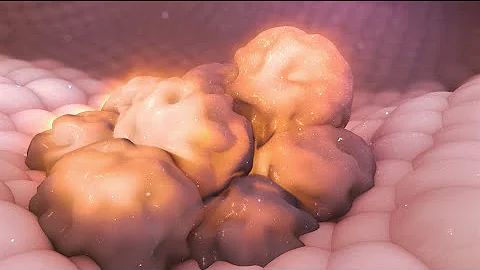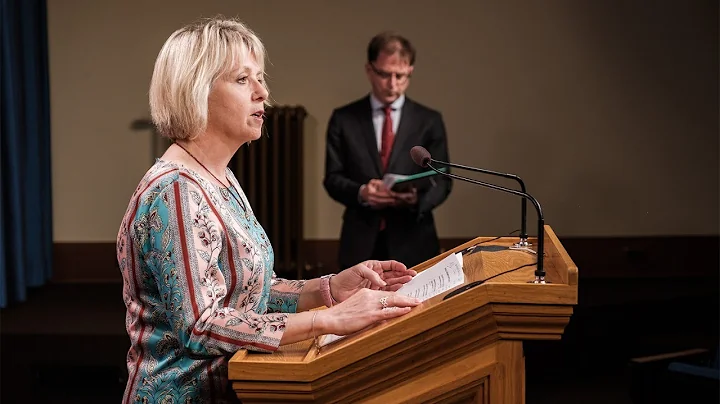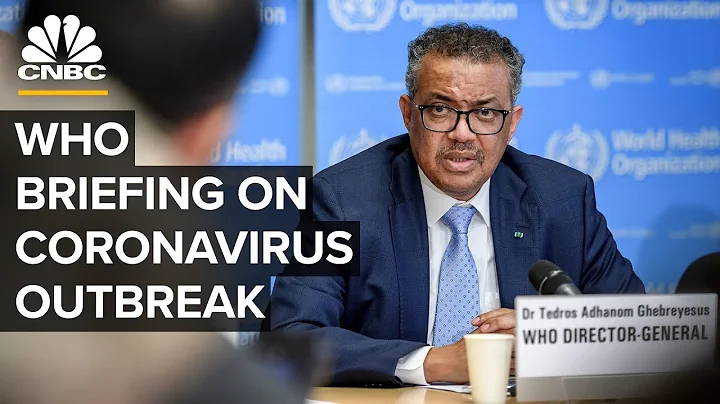Source: Health Times website
Health Times reporters Chen Linhui, Zhao Yuanzhi, Li Zhaoyi
All the chairs have no handles on both sides, and a painting of blue sky and white clouds lights up on the ceiling of the radiotherapy room.
Cancer patients who have been there once all know that chairs without handles are for uncomfortable patients to lie down and rest for a while; blue sky and white clouds are for patients to lie in, although their bodies are undergoing radiotherapy , but what they see in their eyes is is beautiful.
This is the display in the department of Wang Junjie, chairman of the Radiation Oncology Branch of the Chinese Medical Association and director of the Department of Radiation Oncology at Peking University Third Hospital. It is also the place where he has spent more than 20 years.
Radioactive particle ablation treatment accurately "lays landmines" in the body
"At the beginning of this year, my mother's tumor recurred again. If I had known that there was a minimally invasive radiotherapy method, I would have brought my mother here earlier." Patient Huang Xiaomei (pseudonym) The son told reporters.
68-year-old Huang Xiaomei has lost a lot of weight after undergoing radiotherapy and chemotherapy for cervical cancer for more than two years. At the beginning of this year, cervical cancer had a pelvic recurrence for 2 months, and a secondary malignant tumor developed in the bladder. Local doctors advised Huang Xiaomei's two sons to take their mother to the Radiation Oncology Department of Peking University Third Hospital for treatment.
Radiotherapy is one of the troika of cancer treatment. Wang Junjie introduced that in developed countries in Europe and the United States, the proportion of cancer patients receiving radiotherapy is as high as 70%, while in China, less than 24% of the total cancer population receives radiotherapy.
"Before coming here, we were very hesitant and scared, and we were very pessimistic about whether we could continue treatment." Huang Xiaomei's youngest son said that before coming to the hospital, he just hoped that he could stay by his mother's side as much as possible during her last journey and find a way to help her. Ease the pain a little bit.
"The current radioactive particle ablation therapy is like laying landmines in the patient's lesions. Through minimally invasive methods, radioactive particles are distributed according to a certain dose and accurately implanted into the patient's tumor." Before the operation, doctors from Wang Junjie's team said many times He and Huang Xiaomei patiently explained this "landmine burying tactic" to dispel their concerns. In fact, the principle is very simple. It is a minimally invasive, internal irradiation radiotherapy technology that uses low-dose rays emitted by particles to continuously irradiate tumors from the inside out. After 180 days, the implanted particles are metabolized by the body. At the same time, the tumor in the pelvic cavity was eliminated.

"Radioactive particles" are buried in the patient's pelvic cavity. The red particles are tumors and the small yellow particles are implanted radioactive particles. Photo by Li Zhaoyi
Wang Junjie told reporters that the advantage of radioactive particle ablation therapy is that it can form an extremely high dose area inside the tumor (which can be 2-3 times that of conventional radiotherapy). At the same time, because the dose drops quickly and the radiation range is controllable, it has no effect on nearby vital organs. The damage is extremely low, much lower than that of conventional radiotherapy; and because the tumor cells are irradiated continuously and uninterruptedly, unlike the fractionated treatment of external radiation, it does not leave any "breathing time" for the tumor cells to repair some parts.
The difficulty of this technology is how to "lay landmines" on the patient accurately and in accordance with the designed radiotherapy plan. Traditional particle implantation technology mainly relies on individual doctors to insert the implants with their own hands, which is very random, causing the particle distribution after implantation to deviate from the plan, and the efficacy is poor. After years of practice,
Wang Junjie’s team has concretized the brachytherapy plan through customized “3D printing templates” for tumor patients, overcoming the disadvantages of free-hand puncture and improving particle distribution accuracy and treatment effect.

customizes “3D printing templates” for different tumor patients to prepare for accurate “landmine planting”. Photo by Li Zhaoyi
"How well the landmines are buried is the soul of the precision radiotherapy plan." Wang Junjie said that some patients with recurrent tumors often cannot be operated on again, and chemotherapy is usually very ineffective. If external beam radiotherapy is performed again, the dose cannot be increased to a controllable level. effective dose for tumors. With the guidance of imaging technology and the assistance of "3D printing templates", the pain of these patients can be alleviated through accurately buried "landmines".
It took 45 minutes. Huang Xiaomei, who successfully completed the minimally invasive surgery after local anesthesia, was pushed out of the operating room by the medical staff.Huang Xiaomei's eldest son hurriedly stepped forward and stroked his mother's forehead. The younger son did not dare to look at his mother. He was still sitting far away on a chair nearby, rubbing his hands with mixed emotions.
"I didn't expect the operation to be so quick. If I had known we would have come earlier." Listening to his mother and brother chatting happily, Huang Xiaomei's youngest son looked at his mother from a distance, happy and distressed.
Even more fortunately, minimally invasive radioactive particle ablation surgeries like Huang Xiaomei’s are reimbursable by medical insurance, and can be discharged from the hospital 2-3 days after the operation. It is an effective treatment method for such refractory cases, and efficient technology is also It can be combined with conventional radiotherapy to reduce the pain of patients.
The chair handles were removed to allow the patient to lie down and rest for a while.
Seventy-year-old Zhao Ning (pseudonym) found recurrence of local tumor in the pelvis 4 years after rectal cancer surgery. He was initially diagnosed as malignant secondary to retroperitoneal and pelvic lymph nodes. Tumor , left renal pelvis, ureter dilatation, left hydronephrosis, accompanied by coronary atherosclerotic heart disease, ankylosing spondylitis and brain atrophy .
"Don't be sloppy, check again, verify again." Zhao Ning's condition is complicated, and Wang Junjie in the operating room has a serious face, repeatedly verifying the strictly designed radiotherapy plan. From the preset values to the actual implantation and then adjusting to the preset values, Wang Junjie rigorously proofread each data over and over again.
There are three minimally invasive radioactive particle ablation surgeries like Huang Xiaomei's and Zhao Ning's in one afternoon. From the time he entered the operating room at 1 p.m. to the end of the three surgeries, Wang Junjie didn't even bother to take a sip of water.

Director Wang Junjie is implanting radioactive seeds into a patient. Photo by Li Zhaoyi
In 1999, Wang Junjie planned to build the radiotherapy department of Peking University Third Hospital from scratch. He was racing against time and death almost every day.
"There is no room for sloppiness in saving lives and healing the wounded." Wang Junjie said frankly that being a doctor is very hard, but he is tired and happy at the same time.
Nurse Fan Jinghong told reporters that considering that cancer patients are relatively weak, Wang Junjie deliberately removed the handles of all chairs in the department so that patients can have a place to lie down and rest for a while when they feel uncomfortable.
In order to relieve the nervousness and anxiety of tumor patients during the operation, he designed the operating room to be warm and comfortable. Patients have a place to comb their hair and look in the mirror, and they can also see the "blue sky and white clouds" on the roof during the operation. Wang Junjie even paid attention to the material of the foot pads on the operating table and asked the staff to "try lying down" themselves to select the most comfortable foot pads. “Sometimes heals, often helps, always comforts”. This is what Wang Junjie writes on the first page of every notebook.

In every radiotherapy room of Beijing Third Hospital, in order to make patients feel more relaxed, there is a blue sky and white clouds above their heads during each treatment. Photo by Li Zhaoyi
During the follow-up interview, Wang Junjie repeatedly mentioned to reporters the strategy of "not leaving the county for serious illness". While sorting out the examination results and data of each patient, he cited this set of data to reporters: my country currently has about 3.929 million cases of malignant tumors every year, and the incidence of malignant tumors has maintained an annual increase of about 3.9% in the past 10 years. He hopes that doctors from all over the country who come for further training can bring back the latest technologies and let more patients know that there is a "landmine team" of radiotherapy to fight side by side with them to eliminate tumors.
"We haven't given up, and you can't." This is what Wang Junjie has said most to his patients.
This article comes from [Health Times Network] and represents only the author’s views. The National Party Media Information Public Platform provides information release and dissemination services.





















